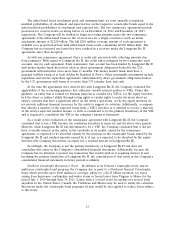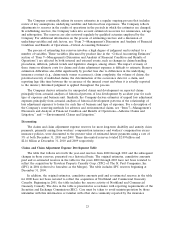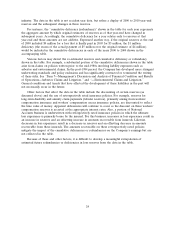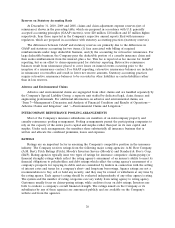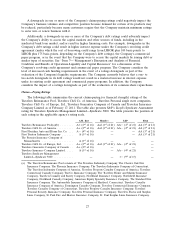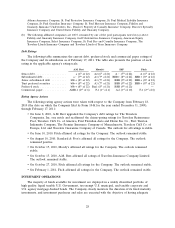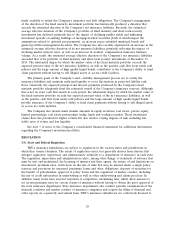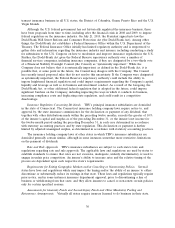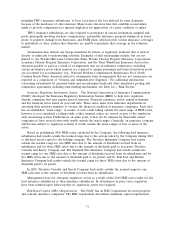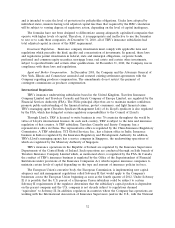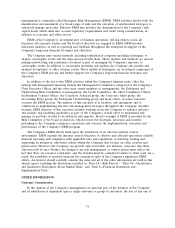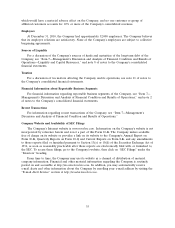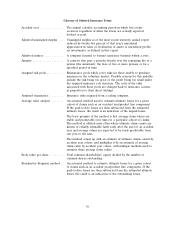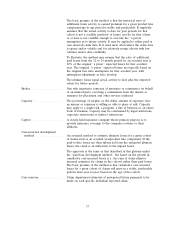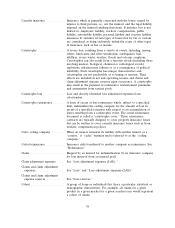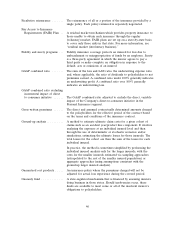Travelers 2010 Annual Report Download - page 43
Download and view the complete annual report
Please find page 43 of the 2010 Travelers annual report below. You can navigate through the pages in the report by either clicking on the pages listed below, or by using the keyword search tool below to find specific information within the annual report.including TRV’s insurance subsidiaries, to bear a portion of the loss suffered by some claimants
because of the insolvency of other insurers. Many states also have laws that establish second-injury
funds to provide compensation to injured employees for aggravation of a prior condition or injury.
TRV’s insurance subsidiaries are also required to participate in various involuntary assigned risk
pools, principally involving workers’ compensation, automobile insurance, property windpools in states
prone to property damage from hurricanes, and FAIR plans, which provide various insurance coverages
to individuals or other entities that otherwise are unable to purchase that coverage in the voluntary
market.
Assessments may include any charge mandated by statute or regulatory authority that is related
directly or indirectly to underwriting activities. Examples of such mechanisms include, but are not
limited to, the Florida Hurricane Catastrophe Fund, Florida Citizens Property Insurance Corporation,
Louisiana Citizens Property Insurance Corporation, and the Texas Windstorm Insurance Association.
Amounts payable or paid as a result of arrangements that are in substance reinsurance, including
certain involuntary pools where insurers are required to assume premiums and losses from those pools,
are accounted for as reinsurance (e.g., National Workers Compensation Reinsurance Pool, North
Carolina Beach Plan). Amounts related to assessments from arrangements that are not reinsurance are
reported as a component of ‘‘General and Administrative Expenses.’’ For additional information
concerning assessments for guaranty funds and second-injury funds and other mandatory pooling and
reinsurance agreements including state-funding mechanisms, see Item 1A—‘‘Risk Factors.’’
Insurance Regulatory Information System. The National Association of Insurance Commissioners
(NAIC) developed the Insurance Regulatory Information System (IRIS) to help state regulators
identify companies that may require special attention. Financial examiners review annual statements
and key financial ratios based on year-end data. These ratios assist state insurance departments in
executing their statutory mandate to oversee the financial condition of insurance companies. Each ratio
has an established ‘‘usual range’’ of results. A ratio result falling outside the usual range of IRIS ratios,
however, is not considered a failing result; rather, unusual values are viewed as part of the regulatory
early monitoring system. Furthermore, in some years, it may not be unusual for financially sound
companies to have several ratios with results outside the usual ranges. Generally, an insurance company
will become subject to regulatory scrutiny if it falls outside the usual ranges of four or more of the
ratios.
Based on preliminary 2010 IRIS ratios calculated by the Company, the following lead insurance
subsidiaries had results outside the normal range due to the actions taken by the Company during 2010
to dividend excess capital to the holding company: The Travelers Indemnity Company had results
outside the normal range for one IRIS ratio due to the amount of dividends received from its
subsidiaries and for three IRIS ratios due to the amount of dividends paid to its parent; Travelers
Casualty and Surety Company and The Standard Fire Insurance Company had results outside the
normal range for one IRIS ratio due to the amount of dividends received from its subsidiaries and for
two IRIS ratios due to the amount of dividends paid to its parent; and St. Paul Fire and Marine
Insurance Company had results outside the normal range for three IRIS ratios due to the amount of
dividends paid to its parent.
In 2009, Travelers Casualty and Surety Company had results outside the normal range for one
IRIS ratio due to the amount of dividends received from its subsidiaries.
Management does not anticipate regulatory action as a result of the 2010 IRIS ratio results for the
lead insurance subsidiaries or their insurance subsidiaries. In all instances in prior years, regulators
have been satisfied upon follow-up that no regulatory action was required.
Risk-Based Capital (RBC) Requirements. The NAIC has an RBC requirement for most property
and casualty insurance companies. The RBC requirement determines minimum capital requirements
31


